Explanation of the Market Order Insight
⁜
Introduction
This function provides detailed insights into market sell and market buy orders through four different charts, based on customizable timeframes (30 minutes, 1 hour, 4 hours, 1 day, and 1 week).
The data is presented visually, making it easy to compare different time periods, helping you gain a comprehensive and accurate view of the market.
There are two main types of orders: limit orders and market orders.
This function is optimized for tracking and analyzing market orders, effectively supporting the analysis of cash flow and identifying key entities influencing price movements.
For limit orders, you can use the Orderbook History tool, a powerful alternative designed to meet the needs of in-depth market analysis.
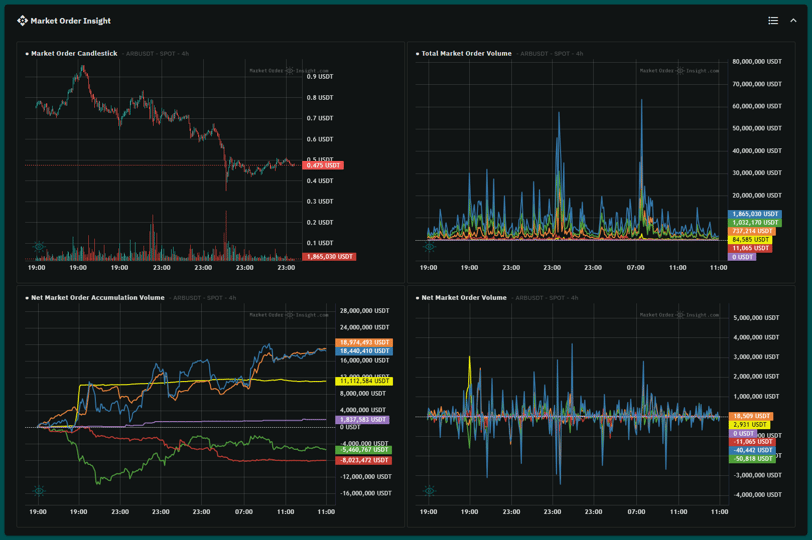

Market Order Candlestick Chart
The chart is divided into two main sections: the candlestick chart at the top and the trading volume chart at the bottom. Its purpose is similar to the candlestick chart used on the Binance exchange.
The data used to generate the chart is entirely sourced from 100% market buy and market sell orders. In some cases, there may be slight differences compared to the live chart on Binance. However, overall, the trend and price structure remain equivalent.
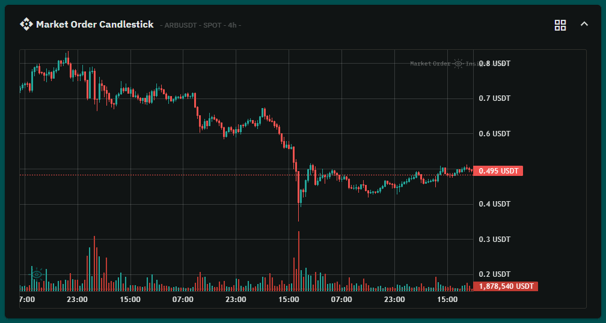

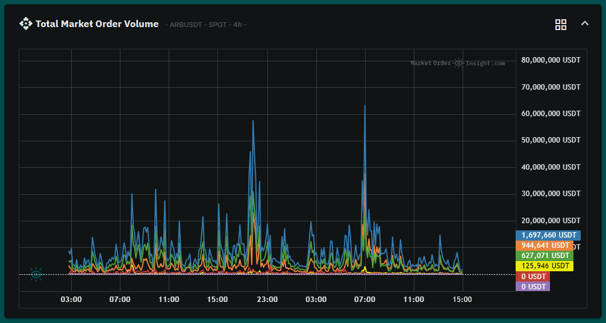

Total Market Order Volume
Total Market Order Volume (TMOV) is the total volume of all market orders (including both market buy and market sell orders) executed within a specific timeframe. This is a relatively basic yet highly useful indicator for assessing the market's level of activity or "heat".
Calculation Formula:
TMOVₜ = BuyVolumeₜ + SellVolumeₜ
BuyVolumeₜ is the total volume of executed market buy orders within the timeframe 𝑡.
SellVolumeₜ is the total volume of executed market sell orders within the timeframe 𝑡.
A unique aspect of the chart is that market orders are categorized into different groups based on the individual order volume. This grouping allows for a clearer visualization of order distribution and market activity. For example:
A market buy/sell order of 100,000 USDT in the ARBUSDT pair will be classified in the red group (see details in the Appendix).
A market buy/sell order of 10,000 USDT will be classified in the green group.
A market buy/sell order of 1,000 USDT will be classified in the orange group.
By segmenting orders into different volume groups, you can easily gauge the activity level of each group at any given time and quickly identify which order group is dominating or being overpowered in the market.
Net Market Order Volume
Net Market Order Volume (NMOV) represents the difference between the market buy volume and the market sell volume within a specific timeframe. This indicator helps you determine whether buying or selling pressure is dominant at a given moment.
Calculation Formula:
NMOVₜ = BuyVolumeₜ − SellVolumeₜ
BuyVolumeₜ is the total volume of executed market buy orders within the timeframe 𝑡.
SellVolumeₜ is the total volume of executed market sell orders within the timeframe 𝑡.
If NMOVₜ > 0: Buyers are dominant (buy orders exceed sell orders).
If NMOVₜ < 0: Sellers are dominant (sell orders surpass buy orders).
If NMOVₜ = 0: Market buy and sell volumes are balanced.
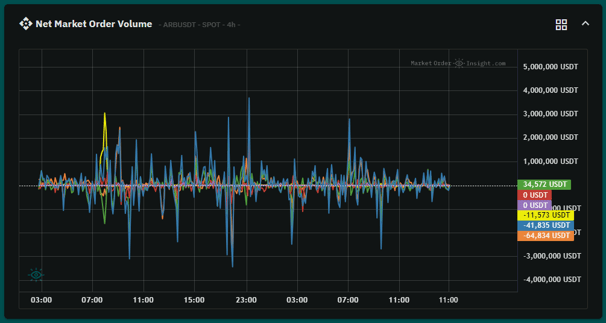

Significance and Applications of NMOV:
Identifying Dominant Buying/Selling Pressure in Short Timeframes
NMOV is the most direct indicator of active buying (buyers pushing the price up) and active selling (sellers pushing the price down).
Compared to Total Volume (TMOV), NMOV highlights who is taking the initiative, as market orders are executed immediately at the best available price.
Supporting Trend Analysis
If price increases along with a rising NMOV (positive), it confirms that the uptrend is backed by active buying pressure.
If price rises but NMOV is negative (or declining), this may be a false signal—the price increase might be due to limit orders being placed lower, rather than buyers actively pushing the price up.
Confirming Breakouts and Breakdowns
When the price is about to break a resistance level, a sudden spike in NMOV suggests that buyers are aggressively placing market orders to push through resistance.
Conversely, if price breaks below a support level and NMOV turns strongly negative, it signals that sellers are actively driving the price down.
Net Market Order Accumulation Volume
Net Market Order Accumulation Volume (NMOAV), sometimes referred to as Cumulative Net Market Order Volume, represents the cumulative accumulation of Net Market Order Volume (NMOV) over a longer period. It provides a broader view of the overall buying/selling trend in the market.
Calculation Formula:
NMOAVₜ = NMOAVₜ₋₁ + NMOVₜ
At the starting point (first timeframe), NMOAV₀ is set to 0.
Example: Calculating NMOAV Using 1-Hour Candles
Take the NMOAV value from the previous hour (𝑡-1).
Add the Net Market Order Volume (Buy - Sell) of the current hour (𝑡).
The result is the NMOAV for the current hour (𝑡).
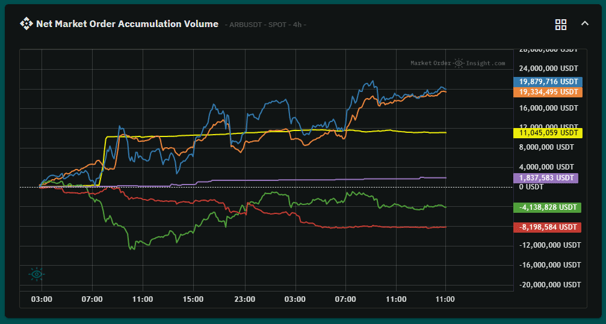

Significance and Applications of NMOAV:
Reflecting Long-Term Capital Flow Trends
Since NMOAV is an accumulated measure, it indicates whether buyers are consistently dominant (NMOAV trending upward) or sellers are in control (NMOAV declining) over an extended period.
Short-term fluctuations may show strong selling pressure in some individual timeframes, but if the overall accumulation trend is rising, it suggests that buying liquidity is still supporting the market.
Filtering Short-Term Noise
Short-term indicators like Net Market Order Volume (NMOV) per candle can experience extreme spikes and dips due to sudden news events or large, one-off trades.
Observing the cumulative Net Market Order Volume (NMOAV) helps distinguish between temporary noise and sustainable market trends.
Confirming Price Trends
If price increases while NMOAV also rises, it suggests that the uptrend is backed by real buying accumulation, making the trend more reliable.
If price increases but NMOAV remains flat or declines, it may indicate a divergence, signaling a potential reversal risk or an unsustainable rally.
Appendix
You can customize the display of different components across all four charts simultaneously within this settings panel.
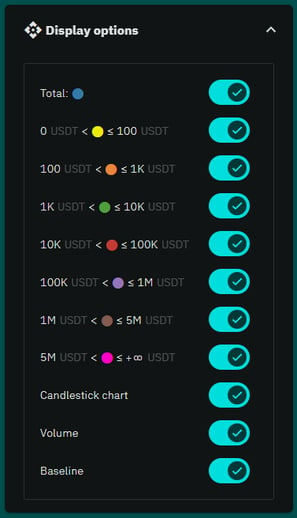

Contact
Customer Support & Care Department
support@marketorderinsight.com


Partners
business@marketorderinsight.com
© 2025 Market Order Insight. All Rights Reserved


About Us
User Guide
Market Order Insight - A comprehensive CEX data analysis platform that helps you uncover critical information behind price fluctuations, enabling more accurate and effective investment decisions.
